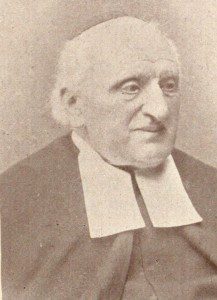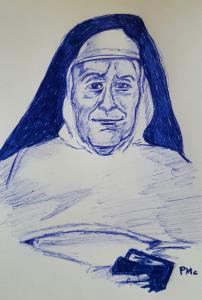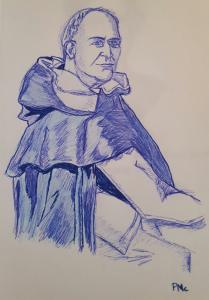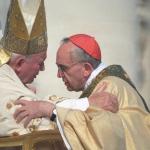 The Brothers of the Christian School (Fratres Scholarum Christianarum) were founded by St. John Baptist De La Salle in 1600’s France. The community first came to the United States in 1848, beginning their work in New York City. Over the next few years the Brothers established parochial schools, high schools and colleges nationwide. Their institutions of higher learning included Manhattan College in New York City, La Salle University in Philadelphia, and Christian Brothers University in Memphis. The following is an account of one of their early members in the United States:
The Brothers of the Christian School (Fratres Scholarum Christianarum) were founded by St. John Baptist De La Salle in 1600’s France. The community first came to the United States in 1848, beginning their work in New York City. Over the next few years the Brothers established parochial schools, high schools and colleges nationwide. Their institutions of higher learning included Manhattan College in New York City, La Salle University in Philadelphia, and Christian Brothers University in Memphis. The following is an account of one of their early members in the United States:
Brother Andronis (Alex Joseph Gadenne, 1811-1898), the last survivor of the founders of the New York community, was born in Lille, in the diocese of Cambrai, France, in 1811. Nothing is known concerning his early life, prior to his admission in the Paris novitiate in the spring of 1836, except that he belonged to a wealthy family and had inherited a considerable patrimony.
In 1837, he began his teaching career in Montereau. Two years later he was transferred to the Parish School of the Holy Infancy. It is possibly for this reason Brother John Chrysostom suggested the name Academy of the Holy Infant Jesus for the boarding school opened in 1853, which ultimately became known as Manhattan College. In 1841, at the age of thirty, because of his maturity of character and edifying piety, Brother Andronis was appointed Director of Novices at Nantes. He held this office for seven years and trained many novices who subsequently occupied positions of eminence in the Institute, such as Brother Cyrion, Vistor of Nantes, and Brother Cyrus, Assistant.
In 1848, Brother Andronis was selected for the New York foundation and appointed Assistant Director of the community and Director of Novices. During the first year at Canal Street, Brother Andronis had no regular class assignment. As Director of Novices, he arranged a room in the attic to serve as the novitiate. During the hours Brother John Chrysostom, the solitary novice, was not engaged in school work, he climbed to this attic room, and there, a sole auditor seated upon a stool in the center of the room, listened to the conferences given in French by Brother Andronis.
In 1849, Father LaFont opened a class in the Brothers’ house for the Negro children of the neighborhood. About fifteen or twenty boys were assembled under Brother Andronis, who, according to Brother John Chrysostom, “had a heart and a half for the undertaking, teaching them with all the zeal and earnestness of his soul.”
The novitiate was transferred to Montreal in 1850 and Brother Andronis accompanied his few novices there. In 1851, he was appointed Director of St. Mary’s Academy, New Orleans, the first school opened by the Brothers in the southern states. He left there in 1853, but for more than half a century afterwards his name was reverently recalled by the residents of that city, so deep and abiding was the impression he had made by the nobility of his life.
The last assignment of Brothers Andronis in America was in the school of Saint Boniface, in Rivière Rouge, Canada, where he remained for six years.
On July 27, 1860, he returned to France and was appointed bursar of the boarding school at Passy. He held that position for thirty-three years. Apparently, he had acquired something of aggressive American business methods during his stay in the United States. At the end of every quarter of the school year, he closed his office and sallied forth on foot on a dunning expedition, armed with a sheaf of unpaid boarding bills. No matter how elusive or ingenious the debtors were, Brother Andronis was equally persistent in tracking them down, He was satisfied only when he could return triumphantly to Passy, to balance his books to the last sou.
His concept of stern duty as demonstrated by his business methods was, however, something apart from the manner of his religious life, although that was equally rigorous and insistent. His years a Director of Novices had schooled him to the obligation of observing the Rule flawlessly, even in minute prescriptions, and of giving edification to his Brothers.
Brother Andronis was blessed with amazing health and vitality. In 1853, while in New Orleans, he escaped the ravages of yellow fever, although many of the younger Brothers were stricken and carried off in a few days. At the age of eighty-two, however, increasing deafness and a gradual impairment of his faculties obliged him to retire from active duty. The last five years of his life were spent in retirement at Caen, The sight of the venerable servant of God, serenely awaiting the summons to his eternal reward, spending the autumn compline of his days in the chapel, made his confreres feel that God still walked upon earth with men of good will. He died on January 11, 1898, the last survivor of the founders of the New York establishment, in the eighty-seventh year of his age and the sixty-second as a Christian Brother. He was buried in the cemetery of the novitiate of Herouville, to which he donated the remainder of his patrimony.
Brother Angelus Gabriel, F.S.C., Ph.D., The Christian Brothers in the United States, 1848-1948: A Century of Catholic Education (New York: The Declan X. McMullen Company, 1948), 108-109.















